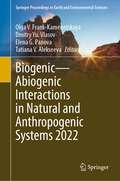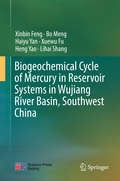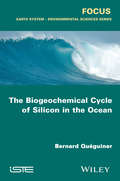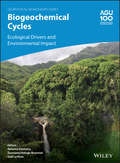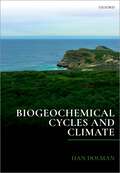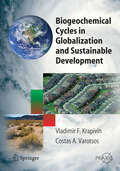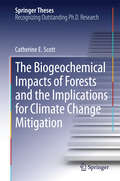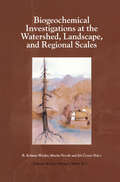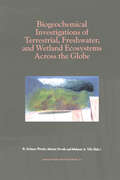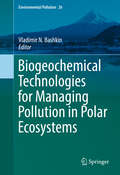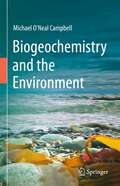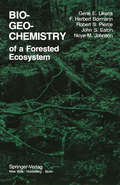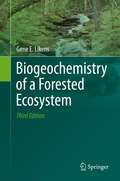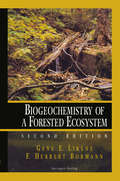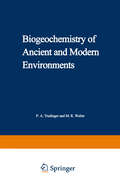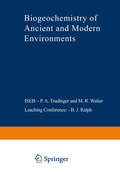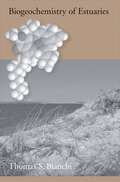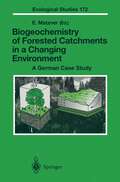- Table View
- List View
Biogenic—Abiogenic Interactions in Natural and Anthropogenic Systems 2022 (Springer Proceedings in Earth and Environmental Sciences)
by Olga V. Frank-Kamenetskaya Dmitry Yu. Vlasov Elena G. Panova Tatiana V. AlekseevaThe book represents a collection of papers presented at VII International Symposium "Biogenic-abiogenic interactions in natural and anthropogenic systems" that was held on 26-29 September 2022 in Saint Petersburg (Russia). Papers in this book cover a wide range of topics connecting with interactions between biogenic and abiogenic components in lithosphere, biosphere and technosphere. The main regarding topics are following: biomineralization in living organisms and nature-like materials; biomineralization in geosystems; geochemistry of biogenic-abiogenic systems; biomineral interactions in soil; interaction of microorganisms with natural and artificial materials; medical geology; philosophical aspects of interdisciplinary researchs
Biogeochemical Cycle of Mercury in Reservoir Systems in Wujiang River Basin, Southwest China
by Xinbin Feng Bo Meng Haiyu Yan Xuewu Fu Heng Yao Lihai ShangThis book presents an intensive study on the biogeochemical cycle of mercury in a river-reservoir system in Wujiang River Basin, the upper branch of the Yangtze River. Six reservoirs located in the mainstream of the Wujiang River and their corresponding inflow/outflow rivers were selected for inclusion in this study, which was conducted by researchers from the Institute of Geochemistry, Chinese Academy of Sciences. The concentration and distribution of Hg in reservoirs (the water column, sediment, sediment pore water), inflow/outflow rivers of reservoirs, and wet deposition in Wujiang River Basin were systematically investigated, and measurements were taken of the water/air exchange flux of gaseous elemental mercury (GEM). On the basis of the data gathered, a detailed mass balance of total mercury (THg) and methylmercury (MeHg) in the six reservoirs was developed. In addition, the book identifies the primary factors controlling Hg methylation in the river-reservoir system in Wujiang River Basin. The accumulation and bio-magnification of Hg species within food chains in reservoirs and human health risk of MeHg exposure through fish consumption are also included in this book.
The Biogeochemical Cycle of Silicon in the Ocean
by Bernard QuéguinerIn the biogeochemical dynamics of marine ecosystems, silicon is a major element whose role has, for a long time, been underestimated. It is however indispensable to the activity of several biomineralizing marine organisms, some of which play an essential role in the biological pump of oceanic carbon. This book presents notions indispensable to the knowledge on the silicon biogeochemical cycle in ocean systems, first of all describing the main quantitative analysis techniques and examination of the major organisms involved in the cycle. The author then moves on to study the most up-to-date processes to control the use of silicon and its regeneration in natural conditions, before mentioning the central role played by this original element in the control of all the biogeochemical cycles in the global ocean. The available information finally enables the global biogeochemical budget of silicon in the marine environment to be quantified.
The Biogeochemical Cycle of Silicon in the Ocean
by Bernard QuéguinerIn the biogeochemical dynamics of marine ecosystems, silicon is a major element whose role has, for a long time, been underestimated. It is however indispensable to the activity of several biomineralizing marine organisms, some of which play an essential role in the biological pump of oceanic carbon. This book presents notions indispensable to the knowledge on the silicon biogeochemical cycle in ocean systems, first of all describing the main quantitative analysis techniques and examination of the major organisms involved in the cycle. The author then moves on to study the most up-to-date processes to control the use of silicon and its regeneration in natural conditions, before mentioning the central role played by this original element in the control of all the biogeochemical cycles in the global ocean. The available information finally enables the global biogeochemical budget of silicon in the marine environment to be quantified.
Biogeochemical Cycles: Ecological Drivers and Environmental Impact (Geophysical Monograph Series #248)
by Katerina Dontsova Zsuzsanna Balogh-Brunstad Gaël Le RouxBiogeochemical Cycles: Ecological Drivers and Environmental Impact is a collection of the latest information on the techniques and methods currently used in this field, focusing on biological and/or ecological effects of biogeochemical elemental cycles including carbon, nitrogen, major and trace elements, chemical weathering on multiple scales of nanometers to watersheds, and advances in technology of studying these processes.Volume highlights include:- Remote sensing and modeling techniques used to quantify changes in the ecosystem/s productivity, and microscopic techniques to estimate the extent of weathering - Novel isotopic techniques to assess changes in trace elemental cycles as influenced by the changing climate, and plant-mediated effect of climate change on major elemental cycles - Impact of climate change and other anthropogenic influences in agricultural and extreme (frontier) environmentsBiogeochemical Cycles: Ecological Drivers and Environmental Impact is a valuable resource for students, researchers and professionals in the field of biogeosciences, hydrology, ecology, earth and planetary surface processes, volcanology, petrology, geochemistry, mineralogy, soil science, agricultural science, climate change and environmental science.
Biogeochemical Cycles: Ecological Drivers and Environmental Impact (Geophysical Monograph Series #248)
by Katerina Dontsova Zsuzsanna Balogh-Brunstad Gaël Le RouxBiogeochemical Cycles: Ecological Drivers and Environmental Impact is a collection of the latest information on the techniques and methods currently used in this field, focusing on biological and/or ecological effects of biogeochemical elemental cycles including carbon, nitrogen, major and trace elements, chemical weathering on multiple scales of nanometers to watersheds, and advances in technology of studying these processes.Volume highlights include:- Remote sensing and modeling techniques used to quantify changes in the ecosystem/s productivity, and microscopic techniques to estimate the extent of weathering - Novel isotopic techniques to assess changes in trace elemental cycles as influenced by the changing climate, and plant-mediated effect of climate change on major elemental cycles - Impact of climate change and other anthropogenic influences in agricultural and extreme (frontier) environmentsBiogeochemical Cycles: Ecological Drivers and Environmental Impact is a valuable resource for students, researchers and professionals in the field of biogeosciences, hydrology, ecology, earth and planetary surface processes, volcanology, petrology, geochemistry, mineralogy, soil science, agricultural science, climate change and environmental science.
Biogeochemical Cycles and Climate
by Han DolmanChanging concentrations of greenhouse gasses are key to our changing climate. Biogochemical Cycles and Climate examines the interaction of the main biogeochemical cycles of the earth with the physics of climate from the perspective of the earth as an integrated system. Biogeochemical cycles play a fundamental role in the Earth's system - they describe the movement of matter and transfer of energy around the planet. This text aims to answer some fundamental questions. How have the cycles of key nutrients, such as carbon, nitrogen, phosphorous, and water changed, both in the geological past and more recently through the impact of humans on the Earth System? How do these cycles interact with each other and affect the physical properties of climate? How can we use this knowledge to mitigate some of the impacts of changing biogeochemistry on climate, and the Earth's habitability and resilience? Understanding the complex interactions of biogeochemistry with the Earth's climate is crucial for understanding past and current changes in climate and above all, for the future sustainable management of our planet.
Biogeochemical Cycles in Globalization and Sustainable Development (Springer Praxis Books)
by Vladimir F. KrapivinThis book presents a new approach to the study of global environmental changes that have unfavorable implications for people and other living systems. The book benefits from the accumulation of knowledge from different sciences. Basic global problems of the nature-society system dynamics are considered. The book aims to develop a universal information technology to estimate the state of environmental subsystems functioning under various climatic and anthropogenic conditions.
Biogeochemical Cycling and Sediment Ecology (NATO Science Partnership Subseries: 2 #59)
by J. Gray William Ambrose Jr. Anna SzaniawskaOceanographic discontinuities (e. g. frontal systems, upwelling areas, ice edges) are often areas of enhanced biological productivity. Considerable research on the physics and biology of the physical boundaries defining these discontinues has been accomplished (see [I D. The interface between water and sediment is the largest physical boundary in the ocean, but has not received a proportionate degree of attention. The purpose of the Nato Advanced Research Workshop (ARW) was to focus on soft-sediment systems by identifying deficiencies in our knowledge of these systems and defining key issues in the management of coastal sedimentary habitats. Marine sediments play important roles in the marine ecosystem and the biosphere. They provide food and habitat for many marine organisms, some of which are commercially important. More importantly from a global perspective, marine sediments also provide "ecosystem goods and services" [2J. Organic matter from primary production in the water column and contaminants scavenged by particles accumulate in sediments where their fate is determined by sediment processes such as bioturbation and biogeochemical cycling. Nutrients are regenerated and contaminants degraded in sediments. Under some conditions, carbon accumulates in coastal and shelf sediments and may by removed from the carbon cycle for millions of years, having a potentially significant impact on global climate change. Sediments also protect coasts. The economic value of services provided by coastal areas has recently been estimated to be on the order of $12,568 9 10 y" [3J, far in excess of the global GNP.
The Biogeochemical Cycling of Sulfur and Nitrogen in the Remote Atmosphere (Nato Science Series C: #159)
by Mary Scott-MarstonViewed from space, the Earth appears as a globe without a beginning or an end. Encompassing the globe is the atmosphere with its three phases- gaseous, liquid, and solid--moving in directions influenced by sunlight, gravity, and rotation. The chemical compositions of these phases are determined by biogeochemical cycles. Over the past hundred years, the processes governing the rates and reactions in the atmospheric biogeochemical cycles have typically been studied in regions where scientists lived. Hence, as time has gone by, the advances in our knowledge of atmospheric chemical cycles in remote areas have lagged substantially behind those for more populated areas. Not only are the data less abundant, they are also scattered. Therefore, we felt a workshop would be an excellent mechanism to assess the state of-knowledge of the atmospheric cycles of sulfur and nitrogen in remote areas and to make recommendations for future research. Thus, a NATO Advanced Research Workshop '~he Biogeochemical Cycling of Sulfur and Nitrogen in the Remote Atmosphere" was held at the Bermuda Biological Station, St. Georges, Bermuda, from 8-12 October 1984. The workshop was attended by 24 international scientists known for their work in atmospheric cycling in remote areas. This volume contains the back ground papers and the discussions resulting from that workshop. The workshop was organized along the lines of the atmospheric cycle. There were working groups on emission, transport, transformation, and deposi tion.
The Biogeochemical Impacts of Forests and the Implications for Climate Change Mitigation (Springer Theses)
by Catherine E. ScottForests and vegetation emit biogenic volatile organic compounds (BVOCs) into the atmosphere which, once oxidized, can partition into the particle phase, forming secondary organic aerosols (SOAs). This thesis reports on a unique and comprehensive analysis of the impact of BVOC emissions on atmospheric aerosols and climate. A state-of-the-art global aerosol microphysics model is used to make the first detailed assessment of the impact of BVOC emissions on aerosol microphysical properties, improving our understanding of the role of these emissions in affecting the Earth’s climate. The thesis also reports on the implications for the climate impact of forests. Accounting for the climate impacts of SOAs, taken together with the carbon cycle and surface albedo effects that have been studied in previous work, increases the total warming effect of global deforestation by roughly 20%.
Biogeochemical Investigations at Watershed, Landscape, and Regional Scales: Refereed papers from BIOGEOMON, The Third International Symposium on Ecosystem Behavior; Co-Sponsored by Villanova University and the Czech Geological Survey; held at Villanova University, Villanova Pennsylvania, USA, June 21–25, 1997
by R. Kelman Wieder Martin Novák Jiří ČernýThis Special Issue of Water, Air, and Soil Pollution offers original contributions from BIOGEOMON, The Third International Symposium on Ecosystem Behavior, which was held on the campus ofVillanova University from June 21-25, 1997. Previous meetings were held in Prague in 1987 and again in 1993. The BIOGEOMON series was initiated in 1987 when a group of researchers from the Czech Geological Survey organized a conference called GEOMON, Geochemical Monitoring in Representative Basins. GEOMON was fairly narrowly focused on monitoring of element pools and fluxes on a small watershed scale. As signalled by the change in name to BIOGEOMON, the second conference explicitly recognized that assessment of anthropogenic effects on ecosystem processes requires a combination of geochemical monitoring with other approaches, including watershed-level manipulations, use of radioactive and stable isotopic tracers, and both empirical and process modeling. The 1997 BIOGEOMON conference was the largest, with over 240 participants from 28 countries on five continents in attendance, and broadest in scope. The conference featured a plenary speaker, six keynote speakers, 35 invited speakers, over 60 oral contributed presentations, and over 75 poster presentations.
Biogeochemical Investigations of Terrestrial, Freshwater, and Wetland Ecosystems across the Globe
by R. Kelman Wieder Martin Novák Melanie A. VileHere is a collection of papers from BIOGEOMON, The Fourth International Symposium on Ecosystem Behavior. The contributions address a wider-than-ever range of concerns: aspects of catchment monitoring and modeling; nitrogen transformations and processes; stable and radiogenic isotopes; biogeochemistry of restored ecosystems; and the dynamics of such chemicals as mercury and phosphorous, among many other topics.
Biogeochemical Monitoring in Small Catchments: Refereed papers from BIOGEOMON, The Symposium on Ecosystem Behaviour: Evaluation of Integrated Monitoring in Small Catchments held in Prague, Czech Republic, September 18–20, 1993
by Jirí Cerný Martin Novák Tomás Paces R. Kelman WiederThis Special Issue of Water, Air and Soil Pollution offers original contributions from BIOGEOMON, an international symposium on ecosystem behavior and the evaluation of integrated monitoring of small catchments, held in Prague, Czech Republic, in September 1993. The meeting attracted nearly 200 scientists from 27 countries on five continents. BIOGEOMON was a loose continuation of another international meeting, GEOMON, which was held in Prague in 1987. Both sym posia provided a forum for the discussion of ideas on environmental problems in western and eastern Europe, with important contributions from the American continent. With the dramatic collapse of the iron curtain, it was our hope that more so than GEOMON, BIOGEOMON would provide opportunities for the free exchange of ideas, fostering the development of research collaborations between its participants. With international openness comes the increasing realization that every indus trialized nation has its own legacy of environmental degradation. Anthropogenic impacts differ in severity and scale; air and water transport of pollutants transform local impacts into regional and global ones, ignoring political boundaries and eco nomic differences. Environmental consequences of anthropogenic activities often are detectable at the ecosystem level. Thus, the challenge of ecosystem science, and to the individuals who practice it, is to develop a comprehensive understanding of ecosystem function in the past and at present, and to apply such understanding toward minimizing future insults to the local, regional, and global environment.
Biogeochemical Processes of Biogenic Elements in China Marginal Seas (Advanced Topics in Science and Technology in China)
by Jinming Song"Biogeochemical Processes of Biogenic Elements in China Marginal Seas" is the first monograph dedicated to this topic. The book mainly presents the latest research achievements of China's national research projects about the biogenic element cycling processes in China marginal seas starting in 1999. By describing the biogeochemical processes of China marginal seas, including the Bohai Sea, the Yellow Sea, the East China Sea, and the South China Sea, it covers almost all kinds of typical ecosystems' regional responses to global oceanic changes of the estuarine ecosystem, the continental shelf ecosystem, the upwelling ecosystem, the coral reef ecosystem, and the mangrove ecosystem. It will be of great interest to scientists and researchers in marine science. Dr. Jinming Song is a professor at Institute of Oceanology, Chinese Academy of Sciences.
Biogeochemical Technologies for Managing Pollution in Polar Ecosystems (Environmental Pollution #26)
by Vladimir N. BashkinThis edited book is devoted to environmental risk management in gas industry impacted polar ecosystems of Russia, one of the hottest topics of modern environmental science. The contributions from experts cover topics that shed new light on the impacts of oil and natural gas production on arctic ecosystems in the country as well as biogeochemical engineering technologies to manage pollution in these areas. Readers will also discover new insights on potential ecological indicators for assessing geo-environmental risks of these impacted ecosystems, and climate modeling in polar areas. The book has interdisciplinary appeal, and specialists and practitioners in environmental sciences, ecology, biogeochemistry and those within the energy sector who are interested in understanding ecosystems affected by anthropogenic impacts in severe climatic conditions will find it particularly engaging. Through this book, readers will learn more about biogeochemical cycling through food chains and specific reactions of biota to environmental pollution in extreme environments through the lens of experts.
Biogeochemical Transformations in the Baltic Sea: Observations Through Carbon Dioxide Glasses (Springer Oceanography)
by Bernd Schneider Jens Daniel MüllerThis book provides a comprehensive review of the biogeochemistry in the Baltic Sea. It is based on the fact that biogeochemical processes that are relevant for the ecological state of the Baltic Sea (and other sea areas), are all in some way related to the production and mineralization of organic matter (biomass) and thus are associated with the consumption or release of CO2. The significant progress with regard to our chemical analytical capabilities concerning the marine CO2 system has facilitated new approaches to study the Baltic Sea biogeochemistry, in particular with regard to a quantitative process understanding. To demonstrate this, the authors present the fundamentals of the marine CO2 system in a theoretically sound, but still intelligible way. This is followed by a comprehensive presentation of our current knowledge about the CO2 system in the Baltic Sea and the implications for our understanding of biogeochemical processes such as production/mineralization of organic matter and the stoichiometry involved, nitrogen fixation, denitrification, and phosphate transformations at varying redox conditions. Finally, the CO2 gas exchange balance and related problems such as acidification are addressed.
Biogeochemistry and the Environment
by Michael O'Neal CampbellBiogeochemistry may be defined as the science that combines biological and chemical perspectives for the examination of the Earth’s surface, including the relations between the biosphere, lithosphere, atmosphere, and hydrosphere. Biogeochemistry is a comparatively recently developed science, that incorporates scientific knowledge and findings, research methodologies, and models linking the biological, chemical, and earth sciences. Therefore, while it is a definitive science with a strong theoretical core, it is also dynamically and broadly interlinked with other sciences. This book examines the complex science of biogeochemistry from a novel perspective, examining its comparatively recent development, while also emphasizing its interlinked relationship with the earth sciences (including the complementary science of geochemistry), the geographical sciences (biogeography, oceanography, geomatics, earth systems science), the biological sciences (ecology, wildlife studies, biological aspects of environmental sciences) and the chemical sciences (including environmental chemistry and pollution). The book covers cutting-edge topics on the science of biogeochemistry, examining its development, structure, interdisciplinary, multidisciplinary, and transdisciplinary relations, and the future of the current complex knowledge systems, especially in the context of technological, developments, and the computer and data fields.
Biogeochemistry of a Forested Ecosystem
by G. E. Likens F. H. Bormann R. S. Pierce J. S. Eaton N. M. JohnsonAbout 15 years ago we began the Hubbard Brook Ecosys tem Study with the development of an ecosystem model and the conception of a method whereby some major parameters of the model could be directly measured under field conditions. The method, called "the small watershed technique," allowed measurement of input and output of chemicals and the construction of ecosystem nutrient bud gets. Although the Hubbard Brook study of nutrient cycling originated with ideas developed by F. H. Bormann and G. E. Likens, its early growth was aided by the remaining authors of this volume-Robert Pierce, forest hydrologist; Noye Johnson, geochemist; and John Eaton, forest ecologist. Donald W. Fisher of the United States Geological Survey also cooperated in the early phases of the project and provided numerous data on the chemistry of precipitation and stream water. Particular credit is due the United States Forest Service, whose scientists chose the Hubbard Brook Valley as a hydrologic study site, selected particular watersheds for intensive measurement, carried out a variety of basic hydrologic studies, and in general cooperated with us in many ways to make the Hubbard Brook Ecosystem Study a reality. The initial part of the ecosystem study was concerned primarily with nutrient flux and cycling and it was done slowly and deliberately. The entire effort during the first few years of study was carried forward by three of us at vi Preface Dartmouth College with the cooperation of the United States Forest Service.
Biogeochemistry of a Forested Ecosystem
by Gene E. LikensThe goal of this Third Edition is to update long-term data presented in earlier editions and to generate new syntheses and conclusions about the biogeochemistry of the Hubbard Brook Valley based on these longer-term data. There have been many changes, revelations, and exciting new insights generated from the longer data records. For example, the impact of acid rain peaked during the period of the HBES and is now declining. The longer-term data also posed challenges in that very marked changes in fluxes occurred in some components, such as hydrogen ion and sulfate deposition, calcium and nitrate export in stream water and biomass accumulation, during the almost 50 years of record. Thus, presenting “mean” or “average” conditions for many components for such a long period, when change was so prominent, do not make sense. In some cases, pentads or decades of time are compared to show these changes in a more smoothed and rational way for this long period. In some cases, a single period, often during periods of rapid change, such as acidification, is used to illustrate the main point(s). And, for some elements a unique mass balance approach, allowing the calculation of the Net Ecosystem Flux (NEF), is shown on an annual basis throughout the study.
Biogeochemistry of a Forested Ecosystem
by Gene E. Likens F.Herbert BormannWhen we originally published Biogeochemistry of a Forested Ecosystem in 1977, the Hubbard Brook Ecosystem Study (HBES) had been in existence for 14 years, and we included data through 1974, or a biogeo chemical record of 11 years. Now our continuous, long-term biogeo chemical records cover more than 31 years, and there have been many changes. The most notable change, however, is that three of our coauthors on the original volume are now deceased. They are deeply missed in so many ways. In spite of the longer records, different trends, and new insights, we believe that the basic concepts and approaches we presented in 1977 represent the most valuable contribution of the original edition. They are still valid and useful, particularly for an introductory study of, or course in, biogeochemistry. Our goal in this revision is to preserve these fea tures, correct errors, and revise or eliminate misleading or ambiguous short-term data (11 years!), while maintaining approximately the original length and the modest cost.
Biogeochemistry of Ancient and Modern Environments: Proceedings of the Fourth International Symposium on Environmental Biogeochemistry (ISEB) and, Conference on Biogeochemistry in Relation to the Mining Industry and Environmental Pollution (Leaching Conference), held in Canberra, Australia, 26 August – 4 September 1979
by P. A. Trudinger M. R. Walter B. J. RalphThis volume contains a selection of papers presented to the Fourth Internation~l Symposium on Environmental Biogeochemistry (ISEB), and a conference on Biogeochemistry in Relation to Mining Industry and Environmental Pollution (Leaching Conference), held in Canberra, Aust ralia on August 26-31 and September 3-4, 1979, respectively. The ISEB were established to provide "a forum for uninhibited exchange of information and ideas among the biological, chemical, atmospheric and geolorical scientists working in the common area of biogeochemistry, encompassing soil and other earth sciences as well as the hydrosphere and atmosphere", By linking the fourth ISEB with the Leachin~ Conference the scope of discussions was extended to encompass the application of biogeochemical processes to the mining industry. This wide-ranging philosophy is reflected in the breadth and diversity of the subjects covered in this book. The published papers are expanded versions of those presented at the meetings. They have all been scrutinized by at least one referee in addition to the editors. About 20% of the contributions to the meetings are not included, either because authors did not wish to publish or because the papers were not accepted by the editors.
Biogeochemistry of Ancient and Modern Environments: Proceedings of the Fourth International Symposium on Environmental Biogeochemistry (ISEB) and, Conference on Biogeochemistry in Relation to the Mining Industry and Environmental Pollution (Leaching Conference), held in Canberra, Australia, 26 August – 4 September 1979
by P. A. Trudinger M. R. Walter B. J. RalphThis volume contains a selection of papers presented to the Fourth International Symposium on Environmental Biogeochemistry (ISEB), and a conference on Biogeochemistry in Relation to Mining Industry and Environmental Pollution (Leaching Conferenc~, held in Canberra, Aust ralia on August 26-31 and September 3-4, 1979, respectively. The ISEB were established to provide "a forum for uninhibited exchange of information and ideas among the biological, chemical, atmospheric and geolopical scientists working in the common area of biogeochemistry, encompassing soil and other earth sciences as weIL as the hydrosphere and atmosphere", By linking the fourth ISEB with the Leachinp Conference the scop.e of discussions was extended to encompass the application of biogeochemical processes to the mining industry. This wide-ranging philosophy is reflected in the breadth and diversity of the subjects covered in this book. The published papers are expanded versions of those presented at the meetings. They have all been scrutinized by at least one referee in addition to the editors. About 20% of the contributions to the meetings are not included, either because authors did not wish to publish or because the papers were not accepted by the editors.
Biogeochemistry of Estuaries
by Thomas S. BianchiBiogeochemistry of Estuaries offers a comprehensive and interdisciplinary approach to understanding biogeochemical cycling in estuaries. Designed as a text for intermediate to advanced students, this book utilizes numerous illustrations and an extensive literature base to impart the current state-of-the-art knowledge in this field. While many of the existing books in estuarine science are comprised of edited volumes, typically focused on highly specific topics in estuaries,Biogeochemistry of Estuaries provides, for the first time, a unique foundation in the areas of geomorphology, geochemistry, biochemistry, aqueous chemistry, and ecology, while making strong linkages (trhoughout the text) to ecosystem-based processes in estuarine sciences. Estuaries, located at the interface between land and the coastal ocean are dynamic, highly productive systems that, in many cases, have been historically associated with development of many of the great centers of early human civilization. Consequentially, these systems have and continue to be highly impacted by anthropogenic inputs. This timely book takes the foundational basis of elemental cycling in estuarine and applies it to estuarine management issues. Biogeochemistry of Estuaries will be welcomed by estuarine/marine scientists, ecologists, biogeochemists, and environmentalists around the world.
Biogeochemistry of Forested Catchments in a Changing Environment: A German Case Study (Ecological Studies #172)
by Egbert MatznerForest ecosystems represent a major type ofland use in Germanyand in Europe. They provide a number of functions, or ecosystem services, beneficial to humans, namely biomass production, regulation of the water- and energy cyde, C and N sequestration, erosion control, recreation, and they act as habitat for numerous species. The stability of forest ecosystems in Europe as influenced by the deposition of air pollutants has been a matter of debate for more than 20 years. Besides atmospheric deposition, other environmental conditions affecting forest ecosystems, such as temperature, CO content of the atmosphere 2 and precipitation, have significantly changed in the past and continue to change in the future. Quantifying and predicting the effects of these changes on ecosys tem functioning are achallenge to ecosystem research and also a requirement to establish sustainable use of forest ecosystems in the future. This book summarizes results of long-term, interdisciplinary ecosystem research conducted in two forested catchments and coordinated at the Bayreuth Institute of Terrestrial Ecosystem Research (BITÖK), University of Bayreuth, Germany. It does not aim to summarize all the research of BITÖ K in the past decade, which would go far beyond the studies in these two catch ments. Instead, we concentrate here on the long-term developments in the biogeochemistry of carbon and mineral elements and on the water cyde, at both the plot and the catchment scale.
